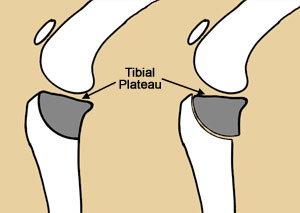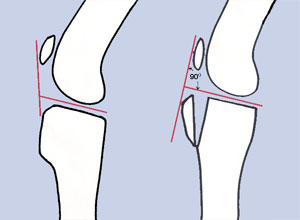TTA – or Tibial Tuberosity Advancement
TTA is the leading-edge solution for your dog’s knee injury.
Let’s talk solutions. Here is where the options start:
The names of each surgery can be confusing, and all of them have different theories as well.The two broad categories are surgeries that:
- attempt replacement of the broken CCL, and
- surgeries that change the geometry of the stifle so that the CCL is not needed.
The surgeries that replace the broken ligament are further divided into two major categories, namely:
• intracapsular repair and
• extracapsular repair.
The capsule refers to the joint capsule, or seal, that surrounds the stifle joint.
The intra-capsular repair uses the body’s natural material to recreate the CCL. This procedure is commonly done in human medicine, but has fallen to the wayside in veterinary medicine, as the results have not been as good as in other procedures. I won’t perform an intracapsular repair, but stay tuned, some researchers are looking at synthetic material inside the joint, and this surgery may make a comeback.
The extracapsular repair is a common form of CCL repair. There are many different ways and materials available to stabilize the stifle joint. This is where much confusion occurs, as all of these procedures have different names, but the theory is the same: re-create the CCL, outside of the joint.
Of these procedures, the only one to use the body’s natural material is a procedure called the lateral fibular head transposition- a fancy name for re-creating the CCL with the lateral collateral ligament.All of the other forms of extracapsular repair use synthetic materials- either polyester, nylon, or proprietary materials (meaning that it is a patented material).
All of these procedures have two things in common:
• they attach on the side of the femur, and
• come forward to attach to the front side of the tibia.
Terms you may hear your vet use are
• lateral suture stability,
• modified Flo,
• femoral tibial suture,
• Tight Rope ™ ,
• Bone Biters™,
and many others.
Some drill tunnels, some use anchors, and some pass around another bone. They are all on the outside of the stifle joint.These procedures are commonly done on smaller dogs, and can be quite successful. They do have their share of problems, especially with larger dogs.
Big dogs can break their real CCL ligament, and they can certainly break or stretch the fake one! As this artificial material is placed on the outside surface of the joint, normal joint mechanics are inhibited.
The stifle joint is like a hinge joint , but there is a bit more to it.
During the stance phase (or weight bearing), the tibia bone does rotate internally a small amount in a normal dog, but this internal rotation is inhibited by the artificial material placed outside of the joint. (I told you vets want to call the stifle joint complex!)
The procedures that we talked about above can still can lead to a non-lame dog, and may be recommended for smaller dogs or older non-active dogs; however, their shortcomings have led to..
… Newer procedures that modify the stifle joint geometry.
Geometry is the study of angles and forces, and these newer procedures use that study to modify joint function by changing angles inside the stifle joint, so that the CCL is not necessary.
These procedures differ greatly from the previous ones that attempt to re-create the CCL.The two most common procedures are the TPLO (tibial plateau leveling Osteotomy), and the TTA, (tibial tuberosity advancement). Both accomplish the same thing, by cutting the tibia bone, making a bony shift, and using a bone plate to hold the cut piece of bone in place.
Tibial Plateau Leveling Osteotomy (or TPLO)
The TPLO, first developed in the mid 1990’s, is explanatory by dissecting the name. The tibia is the bone involved: tibial = bottom bone of the stifle joint. Plateau is the name for the top of the tibia bone inside the joint, where the femur sits. Leveling is in relation to the floor, giving the femur a level spot to sit on the tibial plateau. Osteotomy is a fancy term meaning to cut bone. (The actual angles measured and cut are not to the floor of the surgery room, but this simplifies a basic understanding) See illustration.

Tibial Plateau Leveling Osteotomy (or TPLO) Surgery

Tibial Plateau Leveling Osteotomy (or TPLO) Surgery
Tibial Tuberosity Advancement (or TTA)
The TTA, or tibial tuberosity advancement, is explanatory also by its name. Tibial = relating to the tibia, the lower half of the of the stifle joint. The tuberosity is the front edge of the tibia just below the stifle joint where the patellar tendon attaches, and advancement, meaning to bring forward. The tibial tubersosity (patellar tendon attachment) is just moved forward a certain amount and a spacer is screwed in place to hold it together until the bone cut is healed. The amount of advancement is determined by a right angle (90o of the patellar tendon to the tibial plateau. See illustration.
By advancing the tibial tuberosity to a 90o angle, the stifle joint is stabilized by shifting the weight to the caudal cruciate ligament. In effect there is no longer a need for the cranial cruciate ligament.
If you wish to read in further detail on the mechanics of the TTA procedure, visit the inventor’s website: www.kyonpharma.com – on that website is an exhaustive description of the forces in play on stifle mechanics and how the TTA works. The diagrams are very well done but can be confusing due to the complexity of the stifle joint!
I often get asked…
“…What is the best procedure to do for a CCL rupture?”
That question can only be answered on an individual basis, as each patient is a unique situation and many factors of the patient’s anatomy and lifestyle come into play when making a decision.For most of my patients that are big and active, I do recommend a TTA. If a patient is older, but still very active, I will still recommend a TTA. Some veterinarians will recommend a TPLO and that is fine, as neither are superior in regards to outcome -both procedures are highly successful.
As of this date in 2010, there are no known veterinary surgeons in the world that have learned the TTA method and then switched to using the TPLO method. However, there are plenty of veterinary surgeons that began with the TPLO method and have since started using the TTA instead.
I prefer the TTA method for several reasons.
• The procedure itself is easier to perform, and highly reproducible, meaning we get consistently good results. I want all of my patients that have a TTA surgery to do well!
• TTA patients begin using the leg more quickly than patients having a TPLO procedure, because with the TTA procedure, the tibia is cut only in a non-weight bearing area: The femur sits on top of the uncut portion of the tibia, not through a line cut across the shaft of the tibia, as in the TPLO procedure.
• This means that the chances of a catastrophic mistake or post-surgical injury are much less with the TTA.
Continue to “Results of TTA“





Pingback: Tibial Tubercle Transfer Surgery Knee